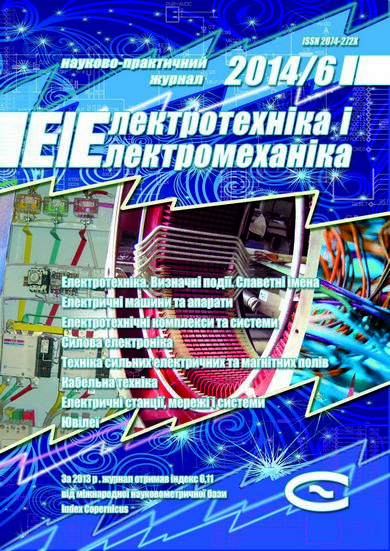ANALYSIS OF FIELD STRUCTURE AND JUSTIFICATION OF VOLTAGES OF DIAGNOSTICS BY PARTIAL DISCHARGES OF SHIELDED TWISTED PAIRS INSULATION
DOI:
https://doi.org/10.20998/2074-272X.2014.6.11Keywords:
partial discharge, electrostatic field, twisted shielded pair, test voltage, symmetric bipolar, unipolar and asymmetric, selective diagnosticsAbstract
An analysis of the electrostatic field of a cable twisted shielded pair for various types of test voltage: symmetric bipolar, unipolar and asymmetric is carried out. Voltage selection affects the location of the most probable place of arising of the partial discharges, phase characteristics of which are used for technical diagnostics of insulation.
References
Brzhezycz'kyj V.O., Myhajlov V.M. Tekhnika i elektrofizyka vysokykh napruh [Technics and Electrophysics of High Voltages]. Kharkov, Tornado Publ., 2005. 930 p.
Bezprozvannych A.V. Ways of representation of differential peak spectra of pulses of partial discharges in solid insulation. Tekhnichna electrodynamika – Technical electrodynamics, 2011, no.4., pp. 12-19.
Bezprozvannych A.V. High electric field and partial discharges in bundled cables. Tekhnichna electrodynamika – Technical electrodynamics, 2010, no.1, pp. 23-29.
Kolechitsky E.S. Numerical method to calculate axisymmetric electrostatic fields. Elektrichestvo – Electricity, 1972, no.7, pp. 57-61.
Tozoni O.V. Metod vtorichnykh istochnikov v elektrotekhnike [Method of secondary sources in electrical engineering]. Moscow, Energy Publ., 1975. 295 p.
Naboka B.G. Raschety elektrostaticheskikh polei v elektroizoliatsionnoi tekhnike: uchebnoe posobie dlia studentov elektroenergeticheskikh spetsial'nostei [Settlements electrostatic fields in the insulating technique: a textbook for students of electric power specialties]. Kiev, IEDL Publ., 1995. 120 p.
Bezprozvannych A.V., Kyessaeyv A.G. Computing experiments for calculation of electrostatic axisymmetric field in piecewise-homogeneous insulation with spherical inclusions. Elektrotekhnіka і elektromekhanіka – Electrical engineering & electromechanics, 2014, no.5, pp. 67-72.
Downloads
Published
How to Cite
Issue
Section
License
Copyright (c) 2015 G. V. Bezprozvannych, A. G. Kyessayev

This work is licensed under a Creative Commons Attribution-NonCommercial 4.0 International License.
Authors who publish with this journal agree to the following terms:
1. Authors retain copyright and grant the journal right of first publication with the work simultaneously licensed under a Creative Commons Attribution License that allows others to share the work with an acknowledgement of the work's authorship and initial publication in this journal.
2. Authors are able to enter into separate, additional contractual arrangements for the non-exclusive distribution of the journal's published version of the work (e.g., post it to an institutional repository or publish it in a book), with an acknowledgement of its initial publication in this journal.
3. Authors are permitted and encouraged to post their work online (e.g., in institutional repositories or on their website) prior to and during the submission process, as it can lead to productive exchanges, as well as earlier and greater citation of published work.





